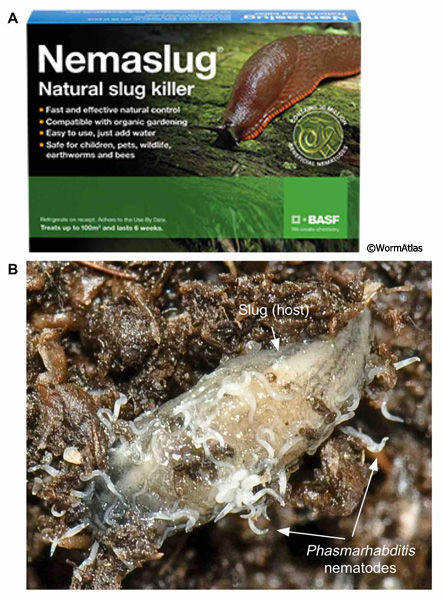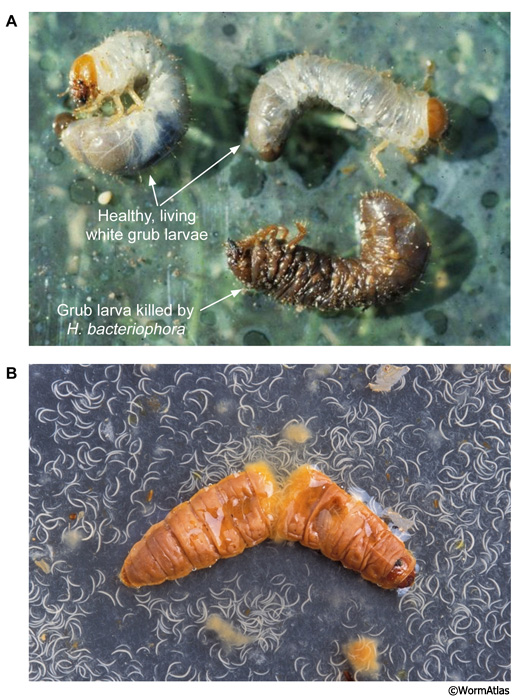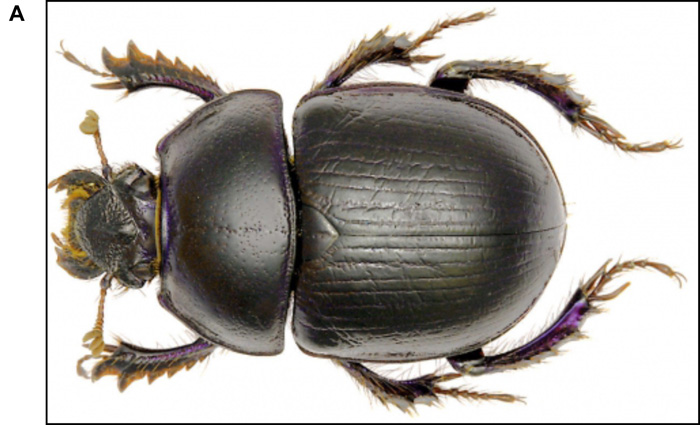
|
|
|
INTRODUCTION TO THE DAUER LARVA - DIAPAUSE IN OTHER SPECIES
 Click pictures for new window with figure and legend, click again for high resolution image Click pictures for new window with figure and legend, click again for high resolution image
|
Developmental diapause has a significant role in the life cycle of many nematode species. The ability to pass through a dauer stage provides the ability to live for a longer time in a resilient form that is protected from many environmental stresses. Thus, diapaused larvae are well-suited for population dispersal and host infection.
1 Entomopathogenic Nematodes
1.1 Phasmarhabditis hermaphrodita
There is growing interest in developing biological control tools based on entomopathogenic nematodes that kill garden pests via infection. (DNemFIG 1A). For most parasitic nematodes, the dauer is the infective stage. One problem in developing pest biocontrols based on nematodes is confirming that nematodes actually cause the death of the host, rather than just persisting as dauers until the host dies from other causes and then recovering from dauer to feed on the host carcass. This issue was investigated for the nematode Phasmarhabditis hermaphrodita, which is a parasite of the grey garden slug Deroceras reticulatum (DNemFIG 1B) (Tan and Grewal, 2001). When injected directly into the slug’s body, most developmental stages of P. hermaphrodita were lethal to the host. However, only dauers were able to infect living slugs from the exterior (Wilson et al., 1993; Tan and Grewal, 2001). Together these findings indicate that dauers are specialized for host infection, and once inside the host, this nematode species is pathogenic to the host.

1.2 Heterorhabditis bacteriophora
Heterorhabditis bacteriophora are insect parasitic nematodes that exist in a symbiotic relationship with the bacteria Photorhabdus luminescens (Ciche, 2007). These symbiotic bacteria are stored in the gut of the Heterorhabditis dauer larva. In the dauer stage, also known as the infective juvenile (IJ), this nematode species disperses through the soil searching for insect hosts. Heterorhabditis dauers can sense host insects directly or by detecting compounds released from plant roots damaged by insect foraging (O’Halloran and Burnell, 2003; Rasmann et al., 2005). Once a suitable host insect is found, the dauer perforates the insect’s exoskeleton using a specialized buccal tooth and then enters the insect host body. Once inside the host, the dauer regurgitates the Photorhabdus luminescens bacteria from its gut into the insect hemocoel where they grow, eventually killing the insect host (Ciche et al., 2008) (DNemFIG 2). The infective dauer recovers, reenters reproductive development and proceeds to produce progeny while feasting on the bacteria produced within the insect body (Strauch and Ehlers, 1998). The bacterium and the nematode act in a mutualistic manner to assist each other in feasting on this host, while the bacterium exudes toxic chemical signals to repel the entry or reproduction of other potential bacterial species (Bai et al., 2013).

1.3 Host Search Strategies of Entomopathogenic Nematodes
Cruising and ambushing are two different host search strategies that have been adopted by the entomopathogenic nematodes (Campbell and Gaugler, 1993). Nematodes that use a cruising strategy move about, exploring a large surface area in search of a host. Dauers of the species Heterorhabditis bacteriophora, Steinernema felitae and Steinernema glaseri utilize the cruising strategy to find their hosts, which are slow-moving grubs and insect larvae in the soil (Campbell and Gaugler, 1993). Nematode species that use an ambushing strategy spend relatively little time engaged in area searches and prefer to nictate with their bodies held off the surface, waiting to be carried off by a passing mobile host. An example of an ambush nematode is Steinernema scapterisci, which infects quick-moving mole crickets (Nguyen and Smart, 1990).
2 Pristionchus Nematodes
The Pristionchus genus, within the family Diplogastridae, includes several hundred free-living nematode species, many of which are found to be closely associated with scarab beetles and Colorado potato beetles (Sommer, 2006). One of the most well-studied Pristionchus species is P. pacificus. In the case of P. pacificus, dauer larvae are found exclusively associated with living scarab beetles (DNemFIG 3) (Meyer and Sommer, 2011). Upon the host beetle’s death, dauers recover and reenter reproductive development, using the beetle carcass as their food source. Studies have shown that dauer entry is triggered by a pheromone that acts species-specifically. Interestingly, some nematode species produce pheromone that acts more potently on sister species than on the self-species (Meyer and Sommer, 2011). Evolutionary pressure on pheromone specificity could cause precocious dauer entry in competing species and help defend against competition for scarce food resources.

|
3 Plant Parasitic Nematodes: Bursaphelenchus xylophilus
Bursaphelenchus xylophilus, also known as pine wood or pine wilt nematodes, are plant parasitic nematodes that cause pine wilt disease (DNemFIG 4) (Linit, 1989). B. xylophilus dauers enter the trachae of Monochamus beetles, which feed and lay eggs in pine wood. The beetle then carries the dauers to fresh pine branches where the dauers enter the wood at wound sites created where the beetle has fed or laid eggs (Linit, 1990). Once within the fresh wood, the dauers recover and proliferate, using the pine wood epithelial cells as a food source (Ferris, 1999). Thus the parasitic nematode species can cause devastation to an important agricultural product; this makes many of the plant parasitic nematode species very unpopular among foresters and farmers.
DNemFIG 4: Bursaphelenchus xylophilus dauers spread pine wilt disease. A. Damage to pine trees due to B. xylophilus infection. (Image source: USDA Forest Service - North Central Research Station Archive, USDA Forest Service, bugwood.org. Obtained from forestryimages.org.) B. Bursaphelenchus xylophilus within an axial resin canal of pinewood (Pinus densiflora). (Image source: Y. Mamiya, bugwood.org. Obtained from forestryimages.org.) |
4 References
Bai, X. Adams, B.J., Ciche, T.A., Clifton, S., Gaugler, R., Kim, K., Spieth, J., Sternberg, P.W., Wilson, R.K. and Grewal, P.S. 2013. A Lover and a Fighter: The Genome Sequence of an Entomopathogenic Nematode Heterorhabditis bacteriophora. PLoS ONE 8: e69618. Article
Campbell, J.F. and R. Gaugler. 1993. Nictation behavior and its ecological implications in the host search strategies of entomopathogenic nematodes (Heterorhabditidae and Steinernematidae). Behavior. 126: 155-169. Abstract
Ciche, T. 2007. The biology and genome of Heterorhabditis bacteriophora. In WormBook (ed. The C. elegans Research Community). WormBook, doi/10.1895/wormbook.1.135.1, http://www.wormbook.org. Article
Ciche, T.A., Kim, K.S., Kaufmann-Daszczuk, B., Nguyen, K.C.Q, and Hall, D. H. 2008. Cell invasion and matricide during Photorhabdus luminscens transmission by Heterorhabditis bacteriophora nematodes. Appl. Environ. Microbiol. 74: 2275–2287. Article
Ferris, H. 1999. Bursaphelenchus xylophilus. http://plpnemweb.ucdavis.edu/nemaplex/Taxadata/G145S1.HTM. Accessed 12/3/2014.
Linit, M.J. 1989. Temporal pattern of pinewood nematode exit from the insect vector Monochamus carolinensis. J. Nematol. 21: 105-107. Article
Linit, M.J. 1990. Transmission of pinewood nematode through feeding wounds of Monochamus carolinensis (Coleoptera: Cerambycidae). J. Nematol. 22: 231-236. Article
Mayer, M.G. and R.J. Sommer. 2011. Natural variation in Pristionchus pacificus dauer formation reveals cross-preference rather than self-preference of nematode dauer pheromones. Proc. R. Soc. B. 278: 2784-2790. Article
Nguyen, K.B. and G.C. Smart, Jr. 1990. Vertical dispersal of Steinernema scapterisci. J. Nematol. 22: 574-578. Article
O’Halloran, D.M. and A.M Burnell. 2003. An investigation of chemotaxis in the insect parasitic nematode Heterorhabditis bacteriophora. Parasitology. 127: 375-85. Abstract
Rasmann, S., Köllner, T.G., Degenhardt, J., Hiltpold, I., Toepfer, S., Kuhlmann, U., Gershenzon, J and T.C.J. Turlings. 2005. Recruitment of entomopathogenic nematodes by insect-damaged maize roots. Nature. 434: 732-737. Abstract
Sommer, R.J. 2006. Pristionchus pacificus. In WormBook (ed The C. elegans Research Community). WormBook, doi/10.1895/wormbook.1.102.1, http://www.wormbook.org. Article
Strauch, O. and R.-U. Ehlers. 1998. Food signal production of Photorhabdus luminescens inducing the recovery of entomopathogenic nematodes Heterorhabditis spp. in liquid culture. Appl. Microbiol. Biotechnol. 50: 369-374. Article
Tan, L. and P.S. Grewal. 2001. Infection behavior of the rhabditis nematode Phasmarhabditis hermaphrodita to the grey garden slug Deroceras reticulatum. J. Parasitol. 87: 1349-1354. Article
Wilson, M.J., D.M. Glen and S.K. George. 1993. The rhabditid nematode Phasmarhabditis hermaphrodita as a potential biological control agent for slugs. Biocontrol. Sci. Techn. 3: 503-511. Article
|

This chapter should be cited as: Wolkow, C.A. and Hall, D.H. 2015. Introduction to the Dauer Larva - Diapause in Other Species. In WormAtlas. doi:10.3908/wormatlas.3.12
Edited for the web by Laura A. Herndon. Last revision: March 20, 2015. |

|
|
|
|